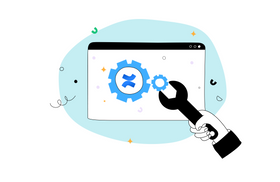The Reasons You Should Integrate IAM With Data Center Security
Published June 30, 2022

Identity and access management, or IAM, is a term used to describe the practice of managing users' identities and the permissions that are associated with them. Essentially, IAM systems help organizations ensure that only authorized users have access to the resources they need, while also keeping track of who has accessed which resources and when. IAM systems can also be used to manage passwords and other authentication information.
The Purpose of Data Center Security
According to a study by Ponemon Institute, the average data breach now costs companies $3.86 million—up 23% from 2013. The healthcare and financial services industries are the most frequently targeted, accounting for 43% and 28% of all data breaches, respectively.
That amount of money can potentially bankrupt a company if not properly secured. In addition, data breaches can cause irreparable damage to a company's reputation, which can lead to fleeing customers and long-term financial losses.
Putting the financial implications aside for a moment, the sheer opportunity for security breaches further highlights that data center security is critical in protecting the privacy of company information.
To put this into perspective, the amount of data created, shared, and stored is growing at an unprecedented rate. The International Data Corporation (IDC) predicts that some 64.2 zettabytes of data were created or replicated in 2020. This rapid growth creates new opportunities for criminals to exploit, as well as new challenges for organizations trying to keep their data safe.
The frightening part?
Data breaches can occur in many ways, but some of the most common is through malware attacks, stolen or compromised credentials, and social engineering schemes. With all this considered, data center security should be a top priority for companies and businesses. No matter the size or scale of their operations.
Data integrity is another serious consideration companies should be making. Learn more about the importance of data integrity here.
How Does IAM Boost Security?
Through the use of IAM, administrators can control access to systems and data, ensuring that only authorized users have access to the information they need. IAM can also help streamline operations by providing a single point of control for user access, making it easier to manage user permissions.
How is this achieved?
IAM systems use a variety of methods—such as passwords, security tokens, and biometric identification—to verify the identities of users and grant them appropriate levels of access. Through these methods, IAM can help boost security by providing a centralized way to control user access, and by enabling administrators to more easily identify and respond to potential security threats. IAM can also help improve compliance with government and industry regulations governing data privacy and security.
During these tough economic times, are you worried about your institutional memory? If so, learn how to preserve your company's institutional memory here.
Benefits of IAM Systems
IAM systems can provide several benefits, including:
- Reduced administrative overhead Managing user identities and access privileges can be a time-consuming task, particularly if there are many users. IAM systems can automate many of the tasks associated with managing users, which can help reduce administrative overhead and make your employees' lives easier.
- Improved compliance posture IAM systems can help organizations meet compliance requirements, such as those set forth by the Payment Card Industry Data Security Standard (PCI DSS) and the Health Insurance Portability and Accountability Act (HIPAA).
- More efficient and secure user authentication IAM systems provide a more efficient and secure way for employees to authenticate themselves when accessing company resources.
- Reduced help desk costs IAM systems can help reduce help desk costs by automating many common tasks, such as password resets.
How to Integrate IAM With Data Center Security
The scale and breadth of potential data risks are rather scary. Thankfully, there are several ways to integrate IAM with data center security.
One of the most effective approaches is to use a federated identity management system. With federated identity management, users can authenticate against a single identity provider, such as Active Directory or LDAP, and then be granted access to multiple resources, both within and outside of the data center.
Businesses can also use role-based access control (RBAC) to manage access to data center resources. RBAC assigns roles to users and groups and then allows those roles to perform certain actions on specific resources.
Worried that the flow of information within your company is compromised? If so, be sure to read about information silos and data federation and how you can better streamline the sharing of information within your organization.
Before you head off, be sure to learn more about how you can improve both document management and knowledge management within your organization.




